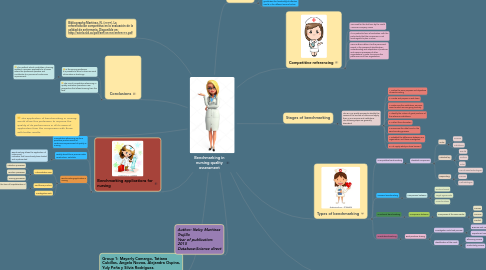
1. Benchmarking applications for nursing
1.1. Competitive referencing can be a proactive practice aimed at continuous improvement of quality in nursing
1.2. Quality should be a process under construction, not static
1.2.1. Benchmarking allows the application of criteria and indicators that have already been tested and implemented
1.3. Benchmarking application in nursing
1.3.1. Administrative area
1.3.1.1. Selection processes
1.3.1.2. Location processes
1.3.1.3. Training processes
1.3.2. Healthcare practice
1.3.2.1. Decrease the time of hospitalization of patients
1.3.3. Investigative work
2. Group 1: Mayerly Camargo, Tatiana Cubillos, Angela Novoa, Alejandra Ospina, Yuly Peña y Silvia Rodríguez.
3. The application of benchmarking in nursing, would allow this profession to improve the quality of its performance in all its areas of application from the comparison with those with better results.
4. Conclusions
4.1. In the nursing profession it is possible to learn to share as much information as teachings
4.1.1. This method, which constitutes a learning method, a process, applicable to all areas where this profession operates and contributes to a process of continuous improvement.
4.2. The use of competitive referencing in quality evaluation provides a new perspective that allows learning from the best
5. Author: Nelcy Martínez Trujillo Year of publication: 2015 Database:Science direct
6. Bibliography:Martínez, N. (2015). La referenciación competitiva en la evaluación de la calidad de enfermería. Disponible en: http://scielo.sld.cu/pdf/enf/v26n3/enf08310.pdf
7. Comparison between internal areas
7.1. High communication level
7.1.1. Suitable experiences, share channels
8. Competitive referencing
8.1. Was used for the first time by the North American company Xerox
8.2. It is a particular form of evaluation, with the particularity that the comparison is not made against a plan or norm
8.3. Some authors define it as the permanent search in the process of identification, understanding and adaptation of practices and superior processes of other organizations in order to improve the performance of their organization
9. Introduction
9.1. Distinctive theme of research in health systems and services
9.2. Its application by nursing professionals guarantees the monitoring of effective results in the different areas of action
10. Stages of benchmarking
10.1. The BM is a quality process to identify the causes of the success of others and apply them in our services and institutions. The following steps are generally described:
10.1.1. 1. Define the area, purpose and objectives of Benchmarking
10.1.2. 2. Create and prepare a work team
10.1.3. 3. Determine the institutions, services, areas to which we are going to study
10.1.4. 4. Identify the criteria of good practices of the reference institutions
10.1.5. 5. Collect the information
10.1.6. 6.Summarize the data found in the Benchmarking process
10.1.7. 7. Establish the differences between our organization and those investigated
10.1.8. 8. Act, apply what you have learned
11. Types of benchmarking
11.1. *Competitive benchmarking
11.1.1. Standard comparison
11.1.1.1. Onto:
11.1.1.1.1. Services
11.1.1.1.2. Institutions
11.1.1.2. Selected by:
11.1.1.2.1. Results
11.1.1.2.2. Perform
11.1.1.2.3. Sales
11.1.1.3. Depending:
11.1.1.3.1. Use of news technologies
11.1.1.3.2. Process
11.1.1.3.3. Methodologics
11.2. *Generic benchmarking
11.2.1. Comparison between
11.2.1.1. Goals achieved
11.2.1.2. Target agreements
11.2.1.3. Cross functions
11.3. *Functional benchmarking
11.3.1. Comparison between
11.3.1.1. Companies of the same sector
11.3.1.1.1. Process
11.3.1.1.2. Services
11.3.1.1.3. Product
11.4. *Inside benchmarking
11.4.1. Best practices sharing
11.4.1.1. Investigation onto best process
11.4.1.1.1. Business unit comparison
11.4.1.1.2. Department comparison
11.4.1.2. Identification of the most:
11.4.1.2.1. Efficiency process
11.4.1.2.2. Productivity process
